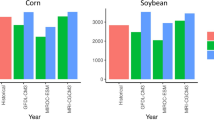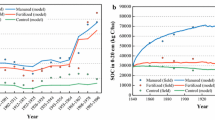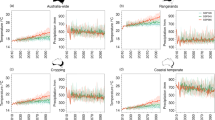Abstract
As the evidence of global climate change continues to mount, its consequences for cropland productivity assume particular significance. Against the backdrop of past agricultural practices, simulation models offer a glimpse into the future, showing the effect of temperature changes on crop production. In this study, we first quantified the carbon (C) and nitrogen (N) budgets of Ohio’s cropland ecosystems using inventory yield data of corn for grain, oat, and all wheat for the period 1866–1996 and soybean for the period 1924–96. Then we explored the responses of Ohio’s continuous soybean croplands to changes in temperature, carbon dioxide (CO2) concentration, initial soil organic C and N (SOC-N) pools, soil texture, and management practices by developing a simple cropland ecosystem model (CEM) and performing a long-term sensitivity analysis. Finally, CEM simulations were evaluated against independent observations of SOC values (0–19 cm) averaged over 470 northwest Ohio sites between 1954 and 1987 under conventional tillage and rotations of corn–soybean–winter wheat by using the historical yield data (r2 = 0.8). The C contents per hectare of crop harvests increased by 178% for oats, 300% for corn for grain, and 652% for all wheat between 1866 and 1996 and by 305% for soybean between 1924 and 1996. Ohio croplands acted as C–N sources, releasing average net ecosystem emissions (NEE), including the removal of harvested C–N, of 4,598 kg CO2 ha−1 and 141 kg N ha−1 in 1886 and 205 kg CO2 ha−1 (except for the corn-for-grain cropland) and 39 kg N ha−1 in 1996. The continuous corn croplands continued to become a C sink, sequestering 255 kg C ha−1 in 1996. Results of the sensitivity analysis for Ohio’s continuous soybean croplands revealed that the SOC pool increased by 6.9% and decreased by 7.5% in response to a doubled CO2 concentration and a temperature increase of 2.8°C over 100 years, respectively. The sequestration potential of the SOC pool increased by 6.5% at a rate of 24.6 kg C ha−1 y−1 for the same period with finer soil texture (loam to silty clay loam). The shift from conventional to conservation residue practice led to an 11% increase in the steady-state SOC storage at a rate of 42 kg C ha−1 y−1 for 100 years.





Similar content being viewed by others
References
GL Ajtay P Ketner P Duvigneaud (1979) Terrestrial primary production and phytomass B Bolin ET Degens S Kempe P Ketnet (Eds) The global carbon cycle. SCOPE 13 Wiley New York 129–81
FA Bazzaz ED Fajer (1992) ArticleTitlePlant life in a CO2-rich world Sci Am 26 68–74
AF Bouwman R Leemans (1995) The role of forest soils in the global carbon cycle WW McFee JM Kelly (Eds) Carbon forms and functions in forest soils Soil Science Society of America Madison (WI) 503–26
Brady, NC, Weil, RR (1996) The nature and properities of soil (11th ed.) Prentice Hall, Upper Saddle River, NJ, 740 pp
GA Buyanovsky G Wagner (1986) ArticleTitlePost-harvest residue input to cropland Plant Soil 93 57–65
JD Cure B Acock (1986) ArticleTitleCrop responses to carbon dioxide doubling: a literature survey Agric For Meteorol 38 127–45 Occurrence Handle10.1016/0168-1923(86)90054-7
PS Curtis LM Balduman BG Drake DF Whigham (1990) ArticleTitleElevated atmospheric CO2 effects on belowground processes in C3 and C4 estuarine marsh communities Ecology 71 2001–6
Donigian AS, Barnwell TO, Jackson RB, Patwardhan AS, Weinrich KB, Rowell AL, Chinnaswamy RV, and others. 1994. Assessment of alternative management practices and policies affecting soil carbon in agroecosystems of the central United States. Report EPA/600/4-94/067. Athens (GA): US Environmental Protection Agency.
J Ehleringer O Bjorkman (1977) ArticleTitleQuantum yields for CO2 uptake in C3 and C4 plants Plant Physiol 59 86–90 Occurrence Handle1:CAS:528:DyaE2sXhtFOktLc%3D
MD Eve M Sperow K Howerton K Paustian RF Follett (2002) ArticleTitlePredicted impact of management changes on soil carbon storage for each cropland region of the conterminous United States J Soil Water Conserv 57 196–204
F Evrendilek MK Wali (2001) ArticleTitleModelling long-term C dynamics in croplands in the context of climate change: a case study from Ohio Env Model Software 16 361–75 Occurrence Handle10.1016/S1364-8152(00)00089-X
AH Fitter RKM Hay (1981) Environmental physiology of plants Academic London 355
J Goudriaan (1992) ArticleTitleBiosphere structure, carbon sequestering potential and the atmospheric 14C carbon record J Exp Bot 43 1111–9
J Goudriaan HE de Ruiter (1983) ArticleTitlePlant growth in response to CO2 enrichment, at two levels of nitrogen and phosphorus supply. I. Dry matter, leaf area and development Netherlands J Agric Sci 31 157–69 Occurrence Handle1:CAS:528:DyaL2cXjs1al
J Goudriaan HH van Laar (1978) ArticleTitleCalculation of daily totals of the gross CO2 assimilation of leaf canopies Netherlands J Agric Sci 26 416–25
J Goudriaan JC Zadoks (1995) ArticleTitleGlobal climate change: modelling the potential responses of agro-ecosystems with special reference to crop protection Environ Pollut 87 215–24 Occurrence Handle10.1016/0269-7491(94)P2609-D Occurrence Handle1:CAS:528:DyaK2MXisFKnt7k%3D Occurrence Handle15091596
DL Harvey (1995) ArticleTitleWarm days, hot nights Nature 377 15–6 Occurrence Handle1:CAS:528:DyaK2MXnvFektr8%3D
InstitutionalAuthorName[IPCC] Intergovernmental Panel on Climate Change (1997) Revised 1996 IPCC guidelines for national greenhouse gas inventories reference manual; vol 3 JT Houghton LG Meria Filho B Lim K Treanton I Mamaty Y Bonduki DJ Griggs GA Callender (Eds) Intergovernmental Panel on Climate Change UK Meteorology Office Bracknell (UK)
RB Jackson (1992) ArticleTitleOn estimating agriculture’s net contribution to atmospheric carbon Water Air Soil Pollut 64 121–37 Occurrence Handle1:CAS:528:DyaK38XksFCqsb8%3D
DS Jenkinson (1991) ArticleTitleThe Rothamsted long-term experiments: are they still of use Agron J 83 2–10
Jensen ME, American Society of Civil Engineers, Haise HR. 1963. Estimating evapotranspiration from solar radiation. J Irrig Drain Div 4:15–41
A Johnston (1997) ArticleTitleThe value of long-term field experiments in agricultural, ecological, and environmental research Adv Agron 59 291–333
BA Kimball JR Mauney FS Nakayama SB Idso (1993) ArticleTitleEffects of elevated CO2 and climate variables on plants J Soil Water Conserv 48 9–14
Kiniry JR, Major DJ, Izaurralde RC, Williams JR, Gassman PW, Morrison M, Bergentine R, and others. 1995. EPIC model parameters for cereal, oilseed, and forage crops in the northern Great Plains region. Can J Plant Sci 75:679–88.
G Kukla TR Karl (1993) ArticleTitleNighttime warming and the greenhouse effect Environ Sci Tech 27 1468–74 Occurrence Handle1:CAS:528:DyaK3sXlsVGgtL4%3D
R Lal RF Follett J Kimble CV Cole (1999) ArticleTitleManaging U.S. cropland to sequester carbon in soil J Soil Water Conserv 54 374–81
BE Law RH Waring PM Anthoni JD Aber (2000) ArticleTitleMeasurements of gross and net ecosystem productivity and water vapour exchange of a Pinus ponderosa ecosystem, and an evaluation of two generalized models Global Change Biol 6 155–68 Occurrence Handle10.1046/j.1365-2486.2000.00291.x
CS Li SE Frolking RC Harriss (1994) ArticleTitleModeling carbon biogeochemistry in agricultural soils Global Biogeochem Cycles 8 237–54 Occurrence Handle10.1029/94GB00767 Occurrence Handle1:CAS:528:DyaK2cXmtVCiu7s%3D
O Monje B Bugbee (1998) ArticleTitleAdaptation to high CO2 concentration in an optimal environment: radiation capture, canopy quantum yield and carbon use efficiency Plant Cell Environ 21 315–24 Occurrence Handle10.1046/j.1365-3040.1998.00284.x Occurrence Handle1:CAS:528:DyaK1cXktVCjt78%3D Occurrence Handle11543216
JL Monteith (1977) ArticleTitleClimate and efficiency of crop production in Britain Philos Trans R Soc London [B] 281 77–294
RT Odell SW Melsted WM Walker (1984) ArticleTitleChanges in organic carbon and nitrogen of Morrow Plot soils under different treatments 1904–1973 Soil Sci 137 160–71 Occurrence Handle1:CAS:528:DyaL2cXitVynu7w%3D
InstitutionalAuthorName[ODA] Ohio Department of Agriculture (1996) Annual report and agricultural statistics 1905–1996 Ohio Agr Stat Serv Columbus (OH)
InstitutionalAuthorNameOhio Agronomy Guide (1989) Bulletin 472. 12th ed Ohio Cooperative Extension Service and Ohio State University Columbus (OH) 78
WJ Parton DS Schimel CV Cole DS Ojima (1987) ArticleTitleAnalysis of factors controlling soil organic matter levels in Great Plains grassland soils Soil Sci Soc Am J 51 1173–9 Occurrence Handle1:CAS:528:DyaL2sXmtlGnsbw%3D
WJ Parton JWB Steward CV Cole (1988) ArticleTitleDynamics of C, N, S, and P in grassland soils: a model Biogeochemistry 5 109–31 Occurrence Handle1:CAS:528:DyaL1cXhvVGlu7w%3D
Parton WJ, Scurlock JMO, Ojima DS, Gilmanov TG, Scholes RJ, Schimel DS, Kirchner T, and others. 1993. Observations and modeling of biomass and soil organic matter dynamics for the grassland biome worldwide. Global Biogeochem Cycles 7:785–809.
K Paustian WJ Parton J Persson (1992) ArticleTitleModeling soil organic matter in organic-amended and nitrogen-fertilized long-term plots Soil Sci Soc Am J 56 476–88
K Paustian CV Cole D Sauerbeck N Sampson (1998) ArticleTitleCO2 mitigation by agriculture: an overview Clim Change 40 135–62 Occurrence Handle10.1023/A:1005347017157 Occurrence Handle1:CAS:528:DyaK1cXmslWgu7k%3D
LA Pinck FE Allison MS Sherman (1950) ArticleTitleMaintenance of soil organic matter. II. Losses of carbon and nitrogen from young and mature plant materials during decomposition in soil Soil Sci 69 391–401 Occurrence Handle1:CAS:528:DyaG3cXlsl2ntg%3D%3D
DS Powlson P Smith JU Smith (1996) Evaluation of soil organic matter models using existing long term datasets. NATO ASI Series I; vol 38 Springer-Verlag New York
C Rosenzweig ML Parry (1994) ArticleTitleImplications of climate change on world food supply Nature 367 133–8 Occurrence Handle10.1038/367133a0
G Russell PG Jarvis JL Monteith (1989) Absorption of radiation by canopies and stand growth G Russell B Marshall PG Jarvis (Eds) Plant canopies: their growth, form and function Cambridge University Press Cambridge (UK) 21–39
TR Sinclair (1998) ArticleTitleHistorical changes in harvest index and crop nitrogen accumulation Crop Sci 38 638–43
V Smil (1999) ArticleTitleCrop residues: agriculture’s largest harvest BioScience 49 299–308
Smith P, Smith JU, Powlson DS, McGill WB, Arah JRM, Chertov OG, Coleman K, and others. 1997. A comparison of the performance of nine soil organic matter models using datasets from seven long-term experiments. Geoderma 81:153–225.
CJT Spitters (1990) ArticleTitleCrop growth models, their usefulness and limitations Acta Hort 267 345–63
CO Stockle PT Dyke JM Williams CA Jones NJ Rosenberg (1992) ArticleTitleA method for estimating the direct and climatic effects of rising atmospheric carbon dioxide on growth and yield of crops. Part II. Sensitivity analysis at three sites in the midwestern USA Agric Syst 38 239–56 Occurrence Handle10.1016/0308-521X(92)90068-Y
InstitutionalAuthorName[USDA] US Department of Agriculture (1996) Historic data: crops by state, 1866–1996 National agricultural statistics system, Government Printing Office Washington (DC)
InstitutionalAuthorName[USDA-ERS] US Department of Agriculture–Economic Research Service (1992) Major land uses by state, 1945–1992 Econ Res Service, Government Printing Office Washington (DC)
InstitutionalAuthorName[US NOAA] US National Oceanic and Atmosphere Administration (1990) National solar radiation data base, 1961–1990 National Climatic Data Center, Government Printing Office Washington (DC)
InstitutionalAuthorName[US NOAA] US National Oceanic and Atmosphere Administration (New York) U.S. precipitation data base, 1948–1997 National Climatic Data Center, Government Printing Office Washington (DC)
HDJ van Heemst (1986) Physiological principles H van Keulen J Wolf (Eds) Modelling of agricultural production, weather, soils, and crops PUDOC Simulation Monographs Wageningen (Netherlands) 13–24
M van Noordwijk SC van de Geijn (1996) ArticleTitleRoot, shoot and soil parameters required for process-oriented models of crop growth limited by water or nutrients Plant Soil 183 1–25 Occurrence Handle1:CAS:528:DyaK28Xnt1alu78%3D
MK Wali F Evrendilek TO West SE Watts D Pant HK Gibbs BE McClead (1999) ArticleTitleAssessing terrestrial ecosystem sustainability: usefulness of regional carbon and nitrogen models Nat Resources 35 IssueID4 21–33
SW Waltman NB Bliss (1997) Estimates of soil organic carbon content for the U.S US Department of Agriculture/NRCS Lincoln (NE)
RT Watson IR Noble B Bolin NH Ravindranath DJ Verardo DJ Dokken (2000) Land use, land-use change, and forestry: a special report of the International Panel on Climate Change Cambridge University Press Cambridge (UK)
JR Williams CA Jones JR Kiniry DA Spanel (1989) ArticleTitleThe EPIC crop growth model Trans Am Soc Agric Eng 32 497–511
Acknowledgments
This research was supported in part by fellowships from the Scholarship Program of the Higher Educational Council, Government of Turkey (to F.E.), and funds from the Ohio State University–College of Food, Agricultural, and Environmental Sciences (to M.K.W.). We thank Frank G. Calhoun for providing soil organic carbon data, Tristram West and Steve Watts for their assistance with ecosystem modeling, and Martin Quigley for comments. We also thank two anonymous reviewers for their comprehensive and thoughtful comments on an earlier version of this paper.
Author information
Authors and Affiliations
Corresponding author
Rights and permissions
About this article
Cite this article
Evrendilek, F., Wali, M. Changing Global Climate: Historical Carbon and Nitrogen Budgets and Projected Responses of Ohio’s Cropland Ecosystems. Ecosystems 7, 381–392 (2004). https://doi.org/10.1007/s10021-004-0017-y
Received:
Accepted:
Published:
Issue Date:
DOI: https://doi.org/10.1007/s10021-004-0017-y




